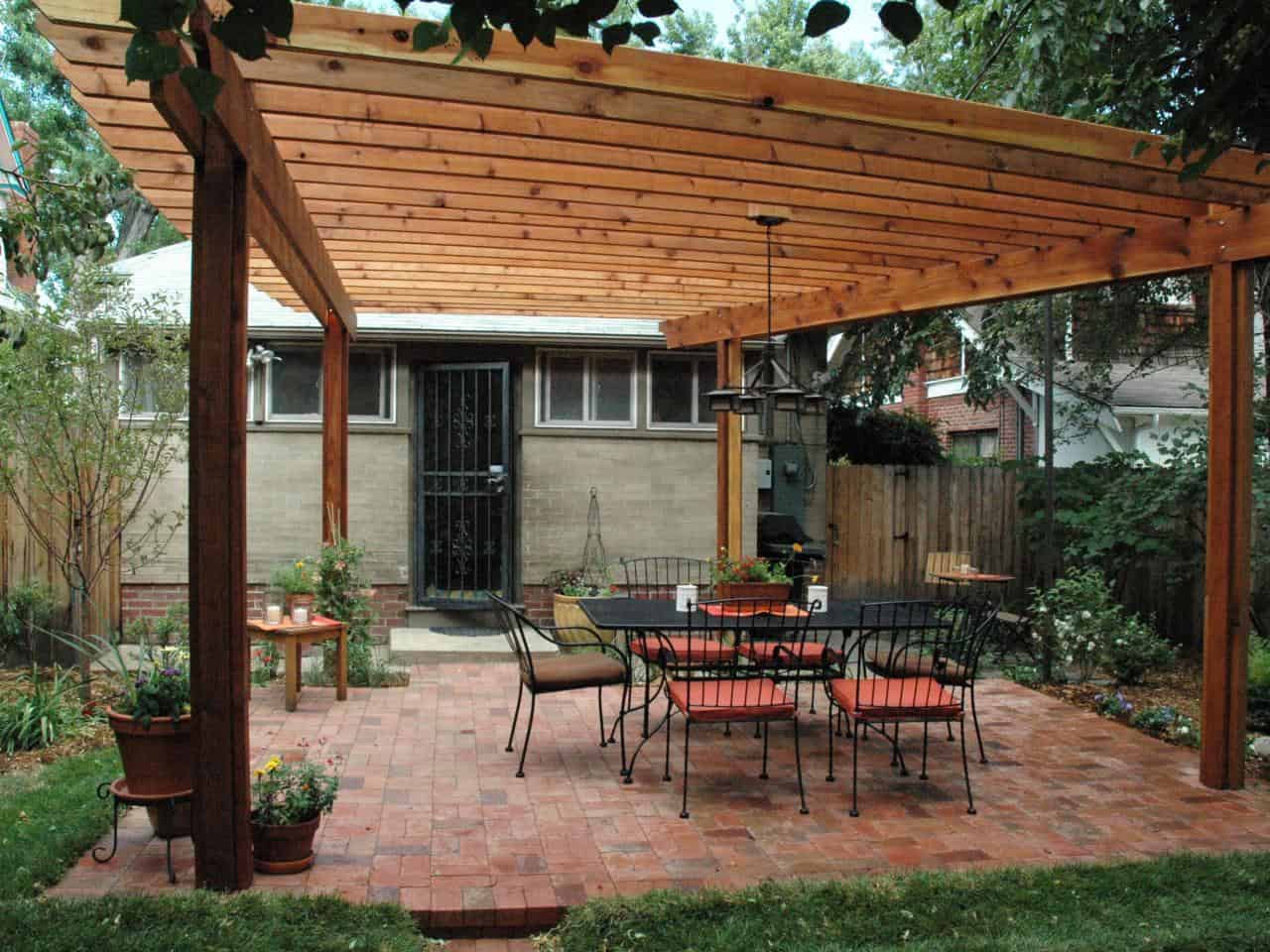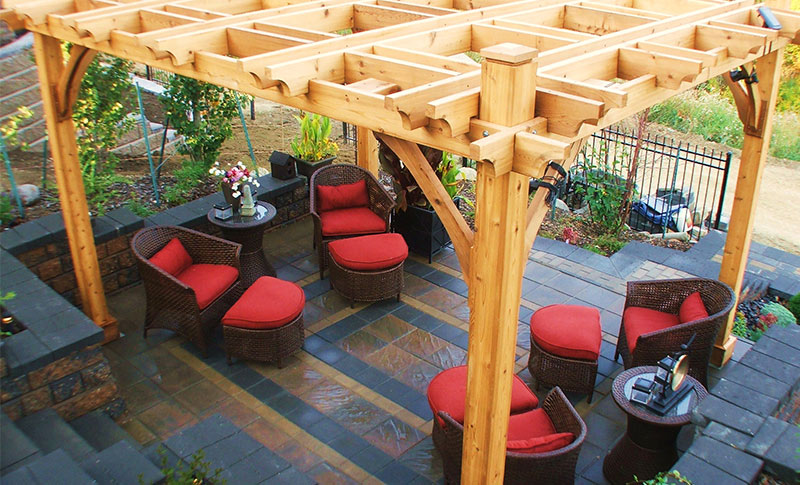Are you looking to have an outdoor structure for yourself and are stuck between a pergola and Gazebo? Here’s all you need to know regarding the two.
Table of Contents
Landscaping can be a significant added advantage to homeowners, especially if you love to spend your time enjoying the great outdoors but within the security of your property. Choosing a good fabrication company to supply quality materials for landscaping is an added advantage.
About Pergolas and Gazebos
Pergolas and gazebos are two of the best forms to construct in your house to add an aesthetic flair to your property. Both structures are beautiful and very beneficial for enjoying your great outdoors. Pergolas and gazebos may serve the same purpose, but they are very different.
Pergola
A pergola is a structure built in the garden, park, or extension of a house that consists of a metallic or wooden framework. They provide partial shelter since the roofing is constructed to allow some sunlight through.
Gazebo
A gazebo, on the other hand, is a stand-alone structure with closed roofing and flooring. They may be open on the sides or have walls with windows and a door.
The difference is that a gazebo has its roofing to create full coverage from sunlight, unlike a pergola.
Having a pergola or a gazebo may be beneficial, but there may also be some disadvantages to having either a pergola or a gazebo. Here are the pros and cons of having either a pergola or having a gazebo.
Pros of having a pergola.
-
They are simple to install.
Outdoor structures come in various designs. Some are expensive, others cheap. Some are easy to construct, and others require a lot of expertise to build. A pergola is easy to assemble and can be made in whichever design the owner desires.
-
Inexpensive.
Pergola is inexpensive in that it requires simple skills to construct and can be easy to DIY at home. They also do not require expensive decors and an interior designer. All one needs is a creative mind and straightforward guiding steps on how to DIY one. If one cannot build a pergola, then one can opt to buy a pergola kit that is readily available online.
-
Adding value to your property.
Like any other outdoor structure, a pergola increases one’s living space and the quality of time spent outside with friends and family, and they add beauty to your home. This makes having a pergola a more excellent value to your property if you decide to sell in the future.
-
They are made of different materials and designs.
Pergola can be made of various materials ranging from wood, metal cider, and any other construction material of choice. The roofing can be made from iron sheets, grass-thatched, pine straws, timber, or even waterproof fabrics. Pergola can be made from a variety of designs, and pergola kits are of various styles.
-
Define outdoor space.
Having a pergola defines your outdoor space in the yard or any area around your home. They make use of space within your home. Pergolas can be built to satisfy various benefits such as an outdoor gardening opportunity, outdoor dining, an entertaining area, an outdoor office, or just a relaxing space to beat the heat.
Cons of having a pergola.
-
Not suitable for extreme weather.
Having a pergola is a lovely escape outside to enjoy the outdoor weather. However, this may not be the case in extreme weather such as rain and strong wind.
-
No protection from insects.
As the name suggests, outdoor structures are built outdoors and lack lockable doors or windows to keep lurking insects away. This makes one vulnerable to insect bites making the great outdoors not as enjoyable as expected.
-
Lack of flooring.
Pergolas are built without considering proper flooring. Having a shade is what is mainly considered when constructing a pergola.
-
Not enough shade.
Pergolas can take up a big or small space in terms of the perimeter; this does not guarantee enough shade. Pergola roofing is made to allow a little light to penetrate through, which makes for not enough shade.
-
No protection from elements.
Pergolas are enjoyable to relax in during calm weather, a little sunshine, and during the day, but elements such as heavy rain, strong winds, and snow makes staying outdoors avoidable and less enjoyable. It is not advisable to remain outdoors in your pergola during such situations since they do not protect you from such.
Gazebo
Pros of having a gazebo
-
Adds value to your property.
Like any other outdoor space, gazebos are very beneficial in increasing the living space, providing beauty within your property, and improving the quality and duration of time spent outside with loved ones. This makes having a gazebo a great addition to your property if one decides to sell in the future.
-
Protection and shade from elements.
Unlike other outdoor structures, the inclusion of permanent roofing, a wall, windows, and a door makes a gazebo a fantastic source of protection from elements such as extreme sunlight, heavy rain, strong winds, and cold.
-
Protection from insects.
Roll-up bug screens and a wall make gazebos an enjoyable outdoor space for relaxing or enjoying a meal. since they offer protection from insects such as mosquitoes, flies, or even pests
-
Privacy.
Gazebo offers privacy. Installing an optional roll-up screen around your Gazebo is a great outdoor space to enjoy a romantic date, a private meeting, or a private gathering without interference from prying eyes.
-
They are firm.
A gazebo is a very sturdy outdoor structure, and because of this, it has little risk of getting destroyed by extreme weather conditions.
-
Allow for electrical installation.
A gazebo is an outdoor structure that protects from extreme weather such as rain. This allows one to run electricity to the Gazebo for an improved outdoor experience like listening to music without worrying about the rain ruining their equipment.
-
Availability of a roof and a floor.
Flooring and roofing are essential for added protection as the roof protects from hot sun and rain and ensures the floors are not muddy. Adding a mat to wipe feet provides your floor, and the interior décor is clean too. Flooring and roofing also make your Gazebo look complete.
-
Built from different materials.
Gazebos are built from different materials such as hardwood, iron materials, and aluminum depending on one’s budget, material preference, and how you want your Gazebo to look after completing the project.
Cons of having a gazebo.
-
Expensive.
Gazebo tends to be very expensive to build compared to other outdoor structures like pergolas. They also require an advanced skill set in construction, expertise and they are simple to DIY at home.
-
They take up more space.
As stated earlier, gazebos are stand-alone structures, unlike pergolas that can be built as a lead-in to the house. This reason makes gazebos take up more yard space and require advanced planning and decision-making before constructing it.
-
High cost of maintenance.
Wooden gazebos require regular maintenance to ensure the wood doesn’t rot, making the Gazebo a dangerous outdoor structure. Steel gazebos may be firm, but they are very hot, especially in summer, and this may require additional equipment such as a cooler this adds extra cost to the Gazebo. Maintenance should also be done on the roof to check for leakages.
Pricing cost of Gazebo vs. pergola.
The pricing cost of either a pergola or Gazebo will depend on; total cost of building, cost of buying construction material, expenditure incurred in interior décor, maintenance cost, cost of buying, and installation for the case of prefab structures.
Gazebos tend to cost more because, unlike pergolas, gazebos take up more yard space. They are constructed as a stand-alone structure, the cost of flooring and roofing, extra costs like electricity, roll-up screens, walls, and windows. Their maintenance cost is also high compared to pergolas.
On the other hand, Pergolas are not very expensive because they are constructed as a temporary shade with a simple roof over four poles, and they do not take up as much space as gazebos. The construction of a pergola is a simple DIY task that may take a few days. Less maintenance cost compared to gazebos.
Breaking down these costs, a 9ft pergola is likely to cost $3,000 and $6,000, with the materials taking about 50% of the total cost.
On the other hand, a gazebo has its price ranging from $5,000 to $10,000, with the material cost being 30% of the total cost and labor making up the difference.
Conclusion
Having an outdoor structure to relax is of very great value to your living space. Pergola and Gazebo are two of the best choices of outdoor designs to choose from. With the above insight on pergolas and gazebos, deciding which outdoor structure to choose from is left solely to you.
You could also opt to hire a professional fabrication company to do it for you. We offer excellent metal fabrication and PVD coating to cater to your pergola and gazebo material needs at eminence metals. Contact us for a quote.
Frequently asked questions
Can A Pergola Be Attached to a House?
Another common question is whether a pergola can be attached to a house to form a patio cover, archway, or other built-in structure. We’re able to attach pergolas to your home, but you should know the permit process can change for attached pergolas versus free-standing ones.
Do Pergolas and gazebos provide shelter from rain and weather?
Pergolas and gazebos are excellent at providing shade. But because pergolas roofs are open, they don’t provide any protection from rain or other precipitation. In comparison, gazebos provide perfect shelter from these elements. There are other options available to give your protective pergola roof, though. Some homeowners use polycarbonate sheeting or clear plastic, for instance, to provide more protection from the elements.
What type of foundation is required for a gazebo
You need to install the gazebo on an even hard surface. Most clients install the gazebo on a wood deck, cement pad, or patio stones. The critical factor is the surface should be level. The entire cement pad or deck can be tilted several degrees for drainage as long as the tilt is in one place.



